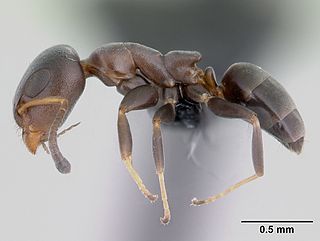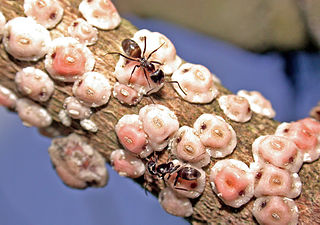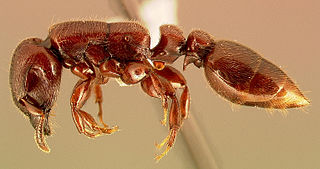
Dolichoderinae is a subfamily of ants, which includes species such as the Argentine ant, the erratic ant, the odorous house ant, and the cone ant. The subfamily presents a great diversity of species throughout the world, distributed in different biogeographic realms, from the Palearctic, Nearctic, Afrotropical region and Malaysia, to the Middle East, Australian, and Neotropical regions.

Turneria is a genus of ants that belongs to the subfamily Dolichoderinae. Known from Australia, they form small colonies of fewer than 500 workers, and nest in trees and twigs.

Dorymyrmex is a genus of ants in the subfamily Dolichoderinae.

Odontomachus is a genus of ants commonly called trap-jaw ants found in the tropics and subtropics throughout the world.

Iridomyrmex is a genus of ants called rainbow ants first described by Austrian entomologist Gustav Mayr in 1862. He placed the genus in the subfamily Dolichoderinae of the family Formicidae. It has 79 described species and five fossil species. Most of these ants are native to Australia; others are found in Asia and Oceania, and they have been introduced to Brazil, New Zealand, and the United Arab Emirates. Fossil species are known from China, France, and the United States.

Aphaenogaster is a genus of myrmicine ants. About 200 species have been described, including 18 fossil species. They occur worldwide except in South America south of Colombia, sub-Saharan Africa, and Antarctica.

Crematogaster is an ecologically diverse genus of ants found worldwide, which are characterised by a distinctive heart-shaped gaster (abdomen), which gives them one of their common names, the Saint Valentine ant. Members of this genus are also known as cocktail ants because of their habit of raising their abdomens when alarmed. Most species are arboreal (tree-dwelling). These ants are sometimes known as acrobat ants.

Pseudomyrmex is a genus of stinging, wasp-like ants in the subfamily Pseudomyrmecinae. They are large-eyed, slender ants, found mainly in tropical and subtropical regions of the New World.

Acropyga is a genus of small formicine ants. Some species can be indirect pests. A. acutiventris, which is found from India to Australia, tends subterranean, root-feeding mealybugs of the species Xenococcus annandalei. Living, gravid females are carried in the jaws of A. acutiventris queens during their nuptial flight, to establish the symbiotic association in founding colonies. Other Acropyga species have relationships with different species of mealybugs, and it could be a trait common to the whole genus.

Paraparatrechina is a genus of small ants in the subfamily Formicinae. The genus contains 31 species distributed in the tropics of Africa, Asia and Australia.

Metapone is an Old World genus of ants in the subfamily Myrmicinae. The genus is found in the Indo-Australian, Oriental and Malagasy regions. Most species are known only from a few specimens.

Pseudolasius is a genus of ants in the subfamily Formicinae. The genus is known from southern Asia to northern Australia, where it appears to be restricted to tropical areas. These ants are commonly known as twig ants due to their habit of nesting in twigs or hollow stems.

Leptomyrmecini is a tribe of Dolichoderinae ants with 16 genera and two extinct genera.

Turneria bidentata is a species of ant in the genus Turneria. Described by Auguste-Henri Forel in 1895, the species is endemic to Australia, mostly found in the north ends of the country.
Turneria collina is a species of ant in the genus Turneria. Described by Shattuck in 1990, the species is endemic to Papua New Guinea.
Turneriapostomma is a species of ant in the genus Turneria. Described by Shattuck in 1990, the species is endemic to Papua New Guinea.
Turneria dahlii is a species of ant in the genus Turneria. Described by Forel in 1901, the species is endemic to New Guinea, the Solomon Islands and Vanuatu.

Turneria pacifica is a species of ant in the genus Turneria. Described by William M. Mann in 1919, the species is endemic to the Solomon Islands and Vanuatu.












